Most of you have probably heard of the Makers movement, which is 3D printing different devices to provide healthcare workers and other professionals with materials until their supply in Spain is guaranteed. However, there are other initiatives based on 3D printing started by people around the world, who have made available product designs whose purpose is to prevent the spread of the Coronavirus. This article presents some of them and reflects on their usefulness. One of the habits that has changed when making purchases is to avoid paying in cash as much as possible. However, there are still people who are not familiar with paying by card or make small purchases that require paying in cash, especially in small businesses. We found a design that allows you to eliminate contact with the coins in case you have to continue using them .
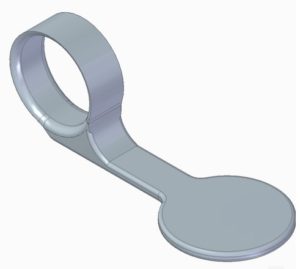 It is a washer that is held with the index finger in a hook shape. From this washer comes a support that ends in a flat, round surface where the coins can be deposited. It is similar to a spoon, but instead of a handle, it has that finger ring.
Although in some ways ingenious, it has several limitations. First, someone must place the coins on the surface and that already involves touching.
Secondly, the flat surface may cause coins to fall. This can be avoided if this surface were designed as a spoon that could also be used to pick up coins from a purse. Even so, we would have to figure out how to get the right amount right.
When collecting them, they could be poured into a box, but it seems difficult to dump them and keep them classified.
Even if the design were improved to avoid the aforementioned drawbacks, it would never be an alternative for a blind person, since they must touch the edge of the coins to identify their value.
So far, we have not found a design that allows bills to be handed over without touching them; some tweezers could help, at least for the exchange.
Within the scope of shopping, an important task is to grab the cart. We have found several designs that can prevent us from touching the surface of the shopping cart pusher, like these two shown below.
It is a washer that is held with the index finger in a hook shape. From this washer comes a support that ends in a flat, round surface where the coins can be deposited. It is similar to a spoon, but instead of a handle, it has that finger ring.
Although in some ways ingenious, it has several limitations. First, someone must place the coins on the surface and that already involves touching.
Secondly, the flat surface may cause coins to fall. This can be avoided if this surface were designed as a spoon that could also be used to pick up coins from a purse. Even so, we would have to figure out how to get the right amount right.
When collecting them, they could be poured into a box, but it seems difficult to dump them and keep them classified.
Even if the design were improved to avoid the aforementioned drawbacks, it would never be an alternative for a blind person, since they must touch the edge of the coins to identify their value.
So far, we have not found a design that allows bills to be handed over without touching them; some tweezers could help, at least for the exchange.
Within the scope of shopping, an important task is to grab the cart. We have found several designs that can prevent us from touching the surface of the shopping cart pusher, like these two shown below.
 The first of these is a clamp that attaches to the push cylinder of a shopping cart . From said clamp comes a handle perpendicular to the ground, with an anatomical shape, so that the person, using two of these devices, could carry the cart without touching its surface.
The first of these is a clamp that attaches to the push cylinder of a shopping cart . From said clamp comes a handle perpendicular to the ground, with an anatomical shape, so that the person, using two of these devices, could carry the cart without touching its surface.
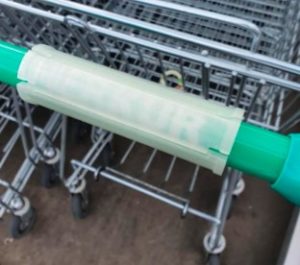 This other design is a longitudinally open cylinder that can be placed around the handle of a shopping cart </ a>to carry it as normal, but without touching the surface.
Both designs seem functional, as long as the person has sufficient motor skills to place the pieces on the cart.
From the Directorate of Universal Accessibility and Innovation of the ONCE Foundation, the possibility of incorporating a rope or cable that ends in a coin to unlock the car has been suggested.
Whenever you design a part in 3D, you have to think about whether or not it makes sense to parameterize it, that is, design it in such a way that before printing it, you can specify some measurements that allow it to better adapt to a specific situation. In the case of products for pushing carts, this option would allow them to adapt to other surfaces to avoid touching them, and in the case of the first design, the handle could be lengthened, making it easier to handle for people with shorter arms, for example.
These days we have acquired the habit of pressing elevator buttons, light switches, etc., with knuckles and elbows. One of the designs that Fundación ONCE has made available to everyone is a small device designed so that people with neurological hands can use keyboards more easily. It is a kind of ring with a small pointer that runs along the back of the phalanx and can be very useful for pressing the buttons of an elevator or an ATM, for example.
This other design is a longitudinally open cylinder that can be placed around the handle of a shopping cart </ a>to carry it as normal, but without touching the surface.
Both designs seem functional, as long as the person has sufficient motor skills to place the pieces on the cart.
From the Directorate of Universal Accessibility and Innovation of the ONCE Foundation, the possibility of incorporating a rope or cable that ends in a coin to unlock the car has been suggested.
Whenever you design a part in 3D, you have to think about whether or not it makes sense to parameterize it, that is, design it in such a way that before printing it, you can specify some measurements that allow it to better adapt to a specific situation. In the case of products for pushing carts, this option would allow them to adapt to other surfaces to avoid touching them, and in the case of the first design, the handle could be lengthened, making it easier to handle for people with shorter arms, for example.
These days we have acquired the habit of pressing elevator buttons, light switches, etc., with knuckles and elbows. One of the designs that Fundación ONCE has made available to everyone is a small device designed so that people with neurological hands can use keyboards more easily. It is a kind of ring with a small pointer that runs along the back of the phalanx and can be very useful for pressing the buttons of an elevator or an ATM, for example.
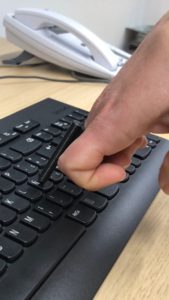 However, we have also found several designs of multipurpose gadgets that can be used to open doors and press buttons.
However, we have also found several designs of multipurpose gadgets that can be used to open doors and press buttons.
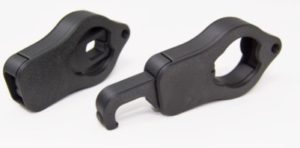 An example is this device that is held as if it had a trigger. The hook at the end is placed over the door handles to lower them without touching them and is also valid for pressing a button.
An example is this device that is held as if it had a trigger. The hook at the end is placed over the door handles to lower them without touching them and is also valid for pressing a button.

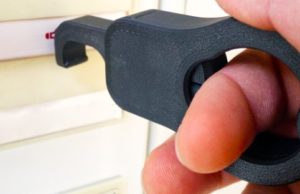 The grip is not going to suit everyone’s needs, and some would probably like a longer hook. This happens with practically all of these designs, the length will determine which more or less people benefit from them.
However, they can all serve as a basis and make the necessary modifications.
The following design has caught our attention because it allows it to always be worn, so that the person is ready at any time.
The grip is not going to suit everyone’s needs, and some would probably like a longer hook. This happens with practically all of these designs, the length will determine which more or less people benefit from them.
However, they can all serve as a basis and make the necessary modifications.
The following design has caught our attention because it allows it to always be worn, so that the person is ready at any time.

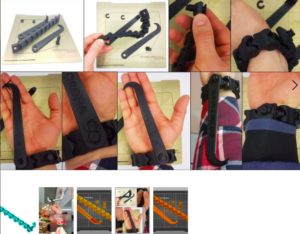 It is a bracelet with a long hook that runs through the palm of the hand. The edge of the hook reaches just before the end of the fingers, exceeding the little finger.
The hook allows you to carry out various tasks, such as hooking a handle to open a door, pressing numbers on a POS, an elevator button, etc.
This peculiar design does not seem easy to install by yourself. You should check if it is comfortable to wear for a long time. Putting it on and taking it off every time a person wants to activate something does not seem like an option.
But given the large number of surfaces we touch throughout the day, having a device that would help us not touch anything, which at the same time would allow us to manipulate, would be a great idea.
It is a bracelet with a long hook that runs through the palm of the hand. The edge of the hook reaches just before the end of the fingers, exceeding the little finger.
The hook allows you to carry out various tasks, such as hooking a handle to open a door, pressing numbers on a POS, an elevator button, etc.
This peculiar design does not seem easy to install by yourself. You should check if it is comfortable to wear for a long time. Putting it on and taking it off every time a person wants to activate something does not seem like an option.
But given the large number of surfaces we touch throughout the day, having a device that would help us not touch anything, which at the same time would allow us to manipulate, would be a great idea.
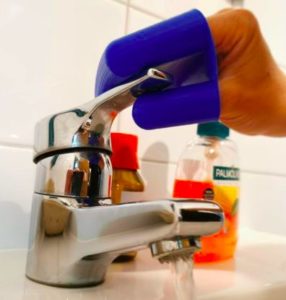 This piece allows you to insert, on one side, the thumb to place it in opposition to the rest of the fingers that are inserted into another piece. The result is a mitten, but that only covers the phalanges of the fingers.
Any tapping action can be performed, but by allowing opposition you can also activate items, such as taps, or grabbing objects.
This design allows objects to be manipulated, at least partially; If the person does not have sensitivity, which is very necessary for many manipulative tasks. However, it can be very useful for people who can put on the mitten without difficulty.
We are sure that, after this pandemic, many places will consider the possibility of installing doors that open by detecting presence or by bringing a hand or foot close to a button, without having to touch. These doors are accessible for people with mobility problems, so they will be very welcome.
But while this happens, you have to continue using doorknobs to move from one room to another.
These designs try to ensure that the person does not have to touch the doors to open them.
This piece allows you to insert, on one side, the thumb to place it in opposition to the rest of the fingers that are inserted into another piece. The result is a mitten, but that only covers the phalanges of the fingers.
Any tapping action can be performed, but by allowing opposition you can also activate items, such as taps, or grabbing objects.
This design allows objects to be manipulated, at least partially; If the person does not have sensitivity, which is very necessary for many manipulative tasks. However, it can be very useful for people who can put on the mitten without difficulty.
We are sure that, after this pandemic, many places will consider the possibility of installing doors that open by detecting presence or by bringing a hand or foot close to a button, without having to touch. These doors are accessible for people with mobility problems, so they will be very welcome.
But while this happens, you have to continue using doorknobs to move from one room to another.
These designs try to ensure that the person does not have to touch the doors to open them.
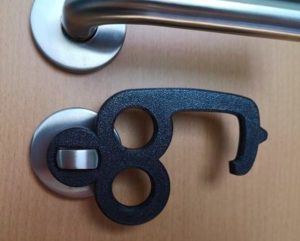 The first example is a flat piece that has a hook and is held by placing the fingers in three circles arranged in a of flower, from which said hook comes out, which allows holding a handle and lowering it.
One of the circles allows you to hold the head of a latch that is activated by turning a quarter of a turn. In this way, the turn can be performed by holding the hook device.
This design may not be universal, meaning it may not fit each and every latch.
However, there are many designs that try to solve the problem of opening doors. Just see if any of them adapt to our needs.
The following is probably one of the designs that we have found that is more functional because it remains securely attached to the door, although it has the drawback that you have to print and install one for each door that you want to adapt.
The rest of the devices for opening doors, such as hooks, can have the problem of slipping from the handles and making the task more difficult than easier. With this design that doesn’t happen.
The first example is a flat piece that has a hook and is held by placing the fingers in three circles arranged in a of flower, from which said hook comes out, which allows holding a handle and lowering it.
One of the circles allows you to hold the head of a latch that is activated by turning a quarter of a turn. In this way, the turn can be performed by holding the hook device.
This design may not be universal, meaning it may not fit each and every latch.
However, there are many designs that try to solve the problem of opening doors. Just see if any of them adapt to our needs.
The following is probably one of the designs that we have found that is more functional because it remains securely attached to the door, although it has the drawback that you have to print and install one for each door that you want to adapt.
The rest of the devices for opening doors, such as hooks, can have the problem of slipping from the handles and making the task more difficult than easier. With this design that doesn’t happen.
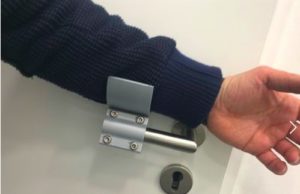 This piece attaches to a door handle with screws. At the top of the latch, a concave surface is arranged, as if it were half a bracelet, where you can place your forearm and push down with it so that the latch goes down.
But we must take into account those people who cannot use their arms, but can use their legs. An example is this knob-shaped piece that sits on a flat base that can be glued or fixed to the bottom of the door leaf, aligned with the handle. This way, you can hook your foot and pull the door open. Although this movement does not seem easy to do for some people, it can be a valid option for others.
This piece attaches to a door handle with screws. At the top of the latch, a concave surface is arranged, as if it were half a bracelet, where you can place your forearm and push down with it so that the latch goes down.
But we must take into account those people who cannot use their arms, but can use their legs. An example is this knob-shaped piece that sits on a flat base that can be glued or fixed to the bottom of the door leaf, aligned with the handle. This way, you can hook your foot and pull the door open. Although this movement does not seem easy to do for some people, it can be a valid option for others.
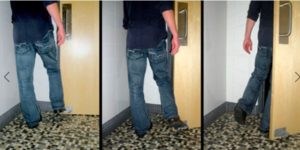 A design that reminds us of grandparents’ tricks is the following. A pita rope or a piece of Velcro are as valid for making adaptations as the most sophisticated material in the world. Here is an example:
A design that reminds us of grandparents’ tricks is the following. A pita rope or a piece of Velcro are as valid for making adaptations as the most sophisticated material in the world. Here is an example:
 It is a rectangular piece, as if it were a window frame, but with smaller dimensions that allow Open the door with your lower limbs. If a rope is tied to the handle and this to the printed piece, it provides a surface to put the foot in and pull down with it, therefore displacing the rope and the handle.
These examples show how, when faced with a need, people are capable of generating ideas.
With or without 3D printers, we have all been using pens these days as elements to press, for example.
When accessibility is perceived as a necessity for all people, we are sure that design for all will be the basis of all creations.
It is a rectangular piece, as if it were a window frame, but with smaller dimensions that allow Open the door with your lower limbs. If a rope is tied to the handle and this to the printed piece, it provides a surface to put the foot in and pull down with it, therefore displacing the rope and the handle.
These examples show how, when faced with a need, people are capable of generating ideas.
With or without 3D printers, we have all been using pens these days as elements to press, for example.
When accessibility is perceived as a necessity for all people, we are sure that design for all will be the basis of all creations.
 It is a washer that is held with the index finger in a hook shape. From this washer comes a support that ends in a flat, round surface where the coins can be deposited. It is similar to a spoon, but instead of a handle, it has that finger ring.
Although in some ways ingenious, it has several limitations. First, someone must place the coins on the surface and that already involves touching.
Secondly, the flat surface may cause coins to fall. This can be avoided if this surface were designed as a spoon that could also be used to pick up coins from a purse. Even so, we would have to figure out how to get the right amount right.
When collecting them, they could be poured into a box, but it seems difficult to dump them and keep them classified.
Even if the design were improved to avoid the aforementioned drawbacks, it would never be an alternative for a blind person, since they must touch the edge of the coins to identify their value.
So far, we have not found a design that allows bills to be handed over without touching them; some tweezers could help, at least for the exchange.
Within the scope of shopping, an important task is to grab the cart. We have found several designs that can prevent us from touching the surface of the shopping cart pusher, like these two shown below.
It is a washer that is held with the index finger in a hook shape. From this washer comes a support that ends in a flat, round surface where the coins can be deposited. It is similar to a spoon, but instead of a handle, it has that finger ring.
Although in some ways ingenious, it has several limitations. First, someone must place the coins on the surface and that already involves touching.
Secondly, the flat surface may cause coins to fall. This can be avoided if this surface were designed as a spoon that could also be used to pick up coins from a purse. Even so, we would have to figure out how to get the right amount right.
When collecting them, they could be poured into a box, but it seems difficult to dump them and keep them classified.
Even if the design were improved to avoid the aforementioned drawbacks, it would never be an alternative for a blind person, since they must touch the edge of the coins to identify their value.
So far, we have not found a design that allows bills to be handed over without touching them; some tweezers could help, at least for the exchange.
Within the scope of shopping, an important task is to grab the cart. We have found several designs that can prevent us from touching the surface of the shopping cart pusher, like these two shown below.
 The first of these is a clamp that attaches to the push cylinder of a shopping cart . From said clamp comes a handle perpendicular to the ground, with an anatomical shape, so that the person, using two of these devices, could carry the cart without touching its surface.
The first of these is a clamp that attaches to the push cylinder of a shopping cart . From said clamp comes a handle perpendicular to the ground, with an anatomical shape, so that the person, using two of these devices, could carry the cart without touching its surface.
 This other design is a longitudinally open cylinder that can be placed around the handle of a shopping cart </ a>to carry it as normal, but without touching the surface.
Both designs seem functional, as long as the person has sufficient motor skills to place the pieces on the cart.
From the Directorate of Universal Accessibility and Innovation of the ONCE Foundation, the possibility of incorporating a rope or cable that ends in a coin to unlock the car has been suggested.
Whenever you design a part in 3D, you have to think about whether or not it makes sense to parameterize it, that is, design it in such a way that before printing it, you can specify some measurements that allow it to better adapt to a specific situation. In the case of products for pushing carts, this option would allow them to adapt to other surfaces to avoid touching them, and in the case of the first design, the handle could be lengthened, making it easier to handle for people with shorter arms, for example.
These days we have acquired the habit of pressing elevator buttons, light switches, etc., with knuckles and elbows. One of the designs that Fundación ONCE has made available to everyone is a small device designed so that people with neurological hands can use keyboards more easily. It is a kind of ring with a small pointer that runs along the back of the phalanx and can be very useful for pressing the buttons of an elevator or an ATM, for example.
This other design is a longitudinally open cylinder that can be placed around the handle of a shopping cart </ a>to carry it as normal, but without touching the surface.
Both designs seem functional, as long as the person has sufficient motor skills to place the pieces on the cart.
From the Directorate of Universal Accessibility and Innovation of the ONCE Foundation, the possibility of incorporating a rope or cable that ends in a coin to unlock the car has been suggested.
Whenever you design a part in 3D, you have to think about whether or not it makes sense to parameterize it, that is, design it in such a way that before printing it, you can specify some measurements that allow it to better adapt to a specific situation. In the case of products for pushing carts, this option would allow them to adapt to other surfaces to avoid touching them, and in the case of the first design, the handle could be lengthened, making it easier to handle for people with shorter arms, for example.
These days we have acquired the habit of pressing elevator buttons, light switches, etc., with knuckles and elbows. One of the designs that Fundación ONCE has made available to everyone is a small device designed so that people with neurological hands can use keyboards more easily. It is a kind of ring with a small pointer that runs along the back of the phalanx and can be very useful for pressing the buttons of an elevator or an ATM, for example.
 However, we have also found several designs of multipurpose gadgets that can be used to open doors and press buttons.
However, we have also found several designs of multipurpose gadgets that can be used to open doors and press buttons.
 An example is this device that is held as if it had a trigger. The hook at the end is placed over the door handles to lower them without touching them and is also valid for pressing a button.
An example is this device that is held as if it had a trigger. The hook at the end is placed over the door handles to lower them without touching them and is also valid for pressing a button.

 The grip is not going to suit everyone’s needs, and some would probably like a longer hook. This happens with practically all of these designs, the length will determine which more or less people benefit from them.
However, they can all serve as a basis and make the necessary modifications.
The following design has caught our attention because it allows it to always be worn, so that the person is ready at any time.
The grip is not going to suit everyone’s needs, and some would probably like a longer hook. This happens with practically all of these designs, the length will determine which more or less people benefit from them.
However, they can all serve as a basis and make the necessary modifications.
The following design has caught our attention because it allows it to always be worn, so that the person is ready at any time.

 It is a bracelet with a long hook that runs through the palm of the hand. The edge of the hook reaches just before the end of the fingers, exceeding the little finger.
The hook allows you to carry out various tasks, such as hooking a handle to open a door, pressing numbers on a POS, an elevator button, etc.
This peculiar design does not seem easy to install by yourself. You should check if it is comfortable to wear for a long time. Putting it on and taking it off every time a person wants to activate something does not seem like an option.
But given the large number of surfaces we touch throughout the day, having a device that would help us not touch anything, which at the same time would allow us to manipulate, would be a great idea.
It is a bracelet with a long hook that runs through the palm of the hand. The edge of the hook reaches just before the end of the fingers, exceeding the little finger.
The hook allows you to carry out various tasks, such as hooking a handle to open a door, pressing numbers on a POS, an elevator button, etc.
This peculiar design does not seem easy to install by yourself. You should check if it is comfortable to wear for a long time. Putting it on and taking it off every time a person wants to activate something does not seem like an option.
But given the large number of surfaces we touch throughout the day, having a device that would help us not touch anything, which at the same time would allow us to manipulate, would be a great idea.
 This piece allows you to insert, on one side, the thumb to place it in opposition to the rest of the fingers that are inserted into another piece. The result is a mitten, but that only covers the phalanges of the fingers.
Any tapping action can be performed, but by allowing opposition you can also activate items, such as taps, or grabbing objects.
This design allows objects to be manipulated, at least partially; If the person does not have sensitivity, which is very necessary for many manipulative tasks. However, it can be very useful for people who can put on the mitten without difficulty.
We are sure that, after this pandemic, many places will consider the possibility of installing doors that open by detecting presence or by bringing a hand or foot close to a button, without having to touch. These doors are accessible for people with mobility problems, so they will be very welcome.
But while this happens, you have to continue using doorknobs to move from one room to another.
These designs try to ensure that the person does not have to touch the doors to open them.
This piece allows you to insert, on one side, the thumb to place it in opposition to the rest of the fingers that are inserted into another piece. The result is a mitten, but that only covers the phalanges of the fingers.
Any tapping action can be performed, but by allowing opposition you can also activate items, such as taps, or grabbing objects.
This design allows objects to be manipulated, at least partially; If the person does not have sensitivity, which is very necessary for many manipulative tasks. However, it can be very useful for people who can put on the mitten without difficulty.
We are sure that, after this pandemic, many places will consider the possibility of installing doors that open by detecting presence or by bringing a hand or foot close to a button, without having to touch. These doors are accessible for people with mobility problems, so they will be very welcome.
But while this happens, you have to continue using doorknobs to move from one room to another.
These designs try to ensure that the person does not have to touch the doors to open them.
 The first example is a flat piece that has a hook and is held by placing the fingers in three circles arranged in a of flower, from which said hook comes out, which allows holding a handle and lowering it.
One of the circles allows you to hold the head of a latch that is activated by turning a quarter of a turn. In this way, the turn can be performed by holding the hook device.
This design may not be universal, meaning it may not fit each and every latch.
However, there are many designs that try to solve the problem of opening doors. Just see if any of them adapt to our needs.
The following is probably one of the designs that we have found that is more functional because it remains securely attached to the door, although it has the drawback that you have to print and install one for each door that you want to adapt.
The rest of the devices for opening doors, such as hooks, can have the problem of slipping from the handles and making the task more difficult than easier. With this design that doesn’t happen.
The first example is a flat piece that has a hook and is held by placing the fingers in three circles arranged in a of flower, from which said hook comes out, which allows holding a handle and lowering it.
One of the circles allows you to hold the head of a latch that is activated by turning a quarter of a turn. In this way, the turn can be performed by holding the hook device.
This design may not be universal, meaning it may not fit each and every latch.
However, there are many designs that try to solve the problem of opening doors. Just see if any of them adapt to our needs.
The following is probably one of the designs that we have found that is more functional because it remains securely attached to the door, although it has the drawback that you have to print and install one for each door that you want to adapt.
The rest of the devices for opening doors, such as hooks, can have the problem of slipping from the handles and making the task more difficult than easier. With this design that doesn’t happen.
 This piece attaches to a door handle with screws. At the top of the latch, a concave surface is arranged, as if it were half a bracelet, where you can place your forearm and push down with it so that the latch goes down.
But we must take into account those people who cannot use their arms, but can use their legs. An example is this knob-shaped piece that sits on a flat base that can be glued or fixed to the bottom of the door leaf, aligned with the handle. This way, you can hook your foot and pull the door open. Although this movement does not seem easy to do for some people, it can be a valid option for others.
This piece attaches to a door handle with screws. At the top of the latch, a concave surface is arranged, as if it were half a bracelet, where you can place your forearm and push down with it so that the latch goes down.
But we must take into account those people who cannot use their arms, but can use their legs. An example is this knob-shaped piece that sits on a flat base that can be glued or fixed to the bottom of the door leaf, aligned with the handle. This way, you can hook your foot and pull the door open. Although this movement does not seem easy to do for some people, it can be a valid option for others.
 A design that reminds us of grandparents’ tricks is the following. A pita rope or a piece of Velcro are as valid for making adaptations as the most sophisticated material in the world. Here is an example:
A design that reminds us of grandparents’ tricks is the following. A pita rope or a piece of Velcro are as valid for making adaptations as the most sophisticated material in the world. Here is an example:
 It is a rectangular piece, as if it were a window frame, but with smaller dimensions that allow Open the door with your lower limbs. If a rope is tied to the handle and this to the printed piece, it provides a surface to put the foot in and pull down with it, therefore displacing the rope and the handle.
These examples show how, when faced with a need, people are capable of generating ideas.
With or without 3D printers, we have all been using pens these days as elements to press, for example.
When accessibility is perceived as a necessity for all people, we are sure that design for all will be the basis of all creations.
It is a rectangular piece, as if it were a window frame, but with smaller dimensions that allow Open the door with your lower limbs. If a rope is tied to the handle and this to the printed piece, it provides a surface to put the foot in and pull down with it, therefore displacing the rope and the handle.
These examples show how, when faced with a need, people are capable of generating ideas.
With or without 3D printers, we have all been using pens these days as elements to press, for example.
When accessibility is perceived as a necessity for all people, we are sure that design for all will be the basis of all creations.